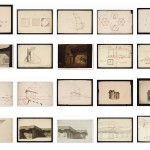William Heath Robinson (1872-1944) was a victorian cartoonist best known for drawing overly complicated mechanisms able to achieve only simple objectives. Despite a big production and a certain recognition in the UK where, during the First World War, the name “Heath Robinson” came to be attributed to any unnecessarily complex and implausible contrivance, only his obvious American counterpart, Rube Goldberg, got international fame (“Rube Goldberg machines” is the name that came to be used from the 1920’s onward in the USA).
Anyway, there are differences: as argued by Adam Gopnik in his introduction to Jennifer George’s The Art of Rube Goldberg, while Robinson’s work is full of “fantasy and whimsy and cosiness”, Goldberg “is thoroughly a cartoonist, in the American, point-scoring style, with the harder tabloid American edge of drawing”. Furthermore, “Robinson’s machines are eccentric; Goldberg’s are practical – you can build them, as in the game of Mouse Trap -and so, because they are practical and buildable, they are, in another way, sinister. They appear too close to actual machines to be dismissed as mere whimsy.” (Quotes Via)
Following this link, you can find all William Heath Robinsons’s Inventions, often with a military propaganda tone in them.
Read a very exhaustive article on Wired.
Via: Victorian Web and Welcome to West House






Leave a Reply